SSSC 23 Things TEC: Thing 22 Legislation Policies and Procedures badge
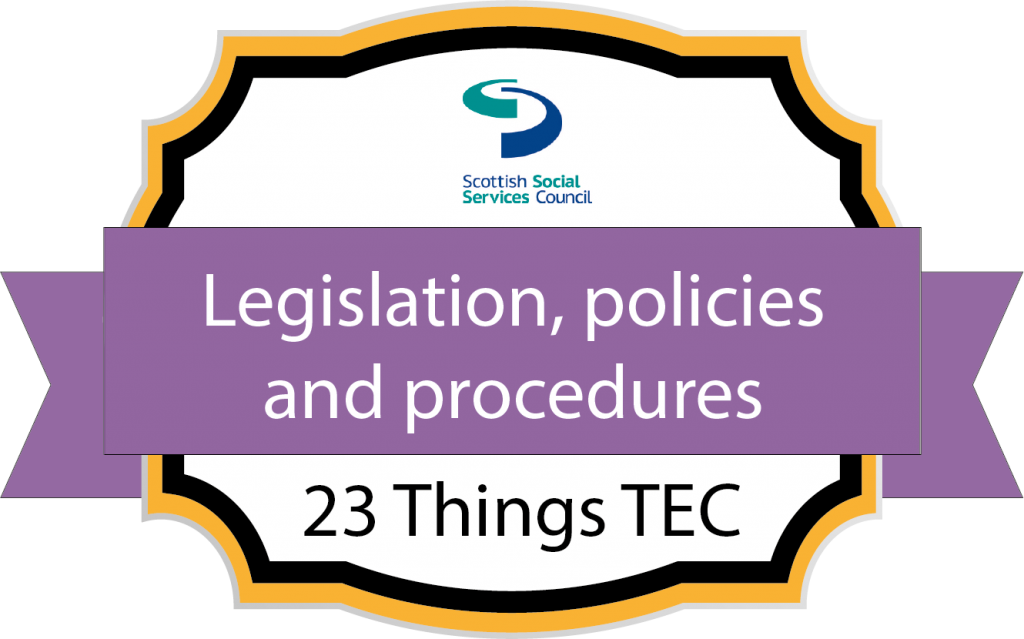
This counts towards the ‘Support and protection’ badge.
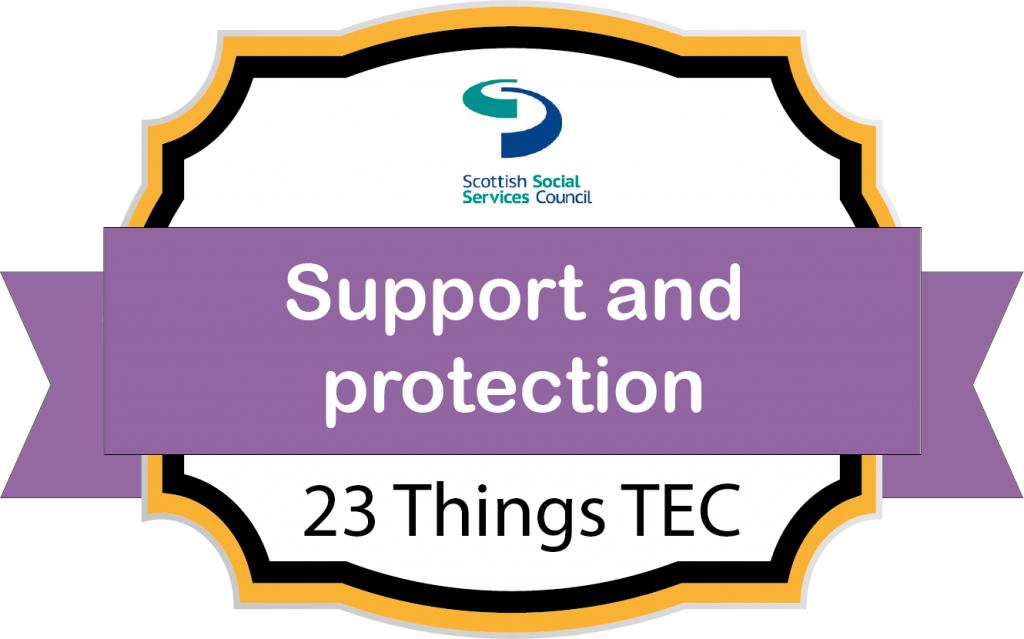
Introduction
Legislation, best practice, and organisational policies govern every aspect of our roles in supporting people to use Technology Enabled Care (TEC). Some legislation, such as the Health and Safety at Work Act 1974, covers all aspects of our work, and we need to know our responsibilities under these Acts regardless of whether we are using Technology or not. Therefore, while we will look at these as they relate to TEC, please ensure that you are also aware of your wider responsibilities under legislation for your role.
Throughout this Thing, we have used the book ‘Social care and the Law in Scotland (11th edition)’ by Siobhan Maclean and Mark Shiner (Kirwin Maclean Associates) for guidance.
Please note that in 23 Things TEC, we cannot include all legislation that covers every role in social services in Scotland. There may be other legislation specific to your role. Please ensure that you know this and if in doubt whether it applies to you, ask your line manager/supervisor.
Health and safety
The Health and safety at Work Act 1974, mentioned above, is the primary legislation that covers your health and safety while you are working. The Act places duties on employers, managers and employees. These are summarised in the boxes below.
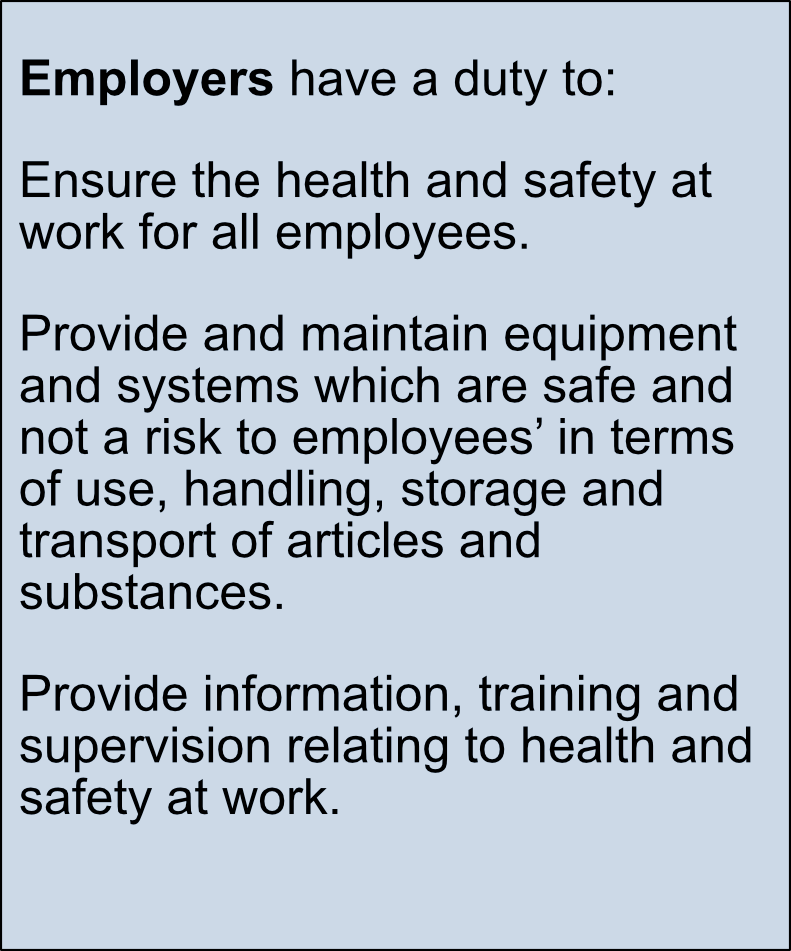

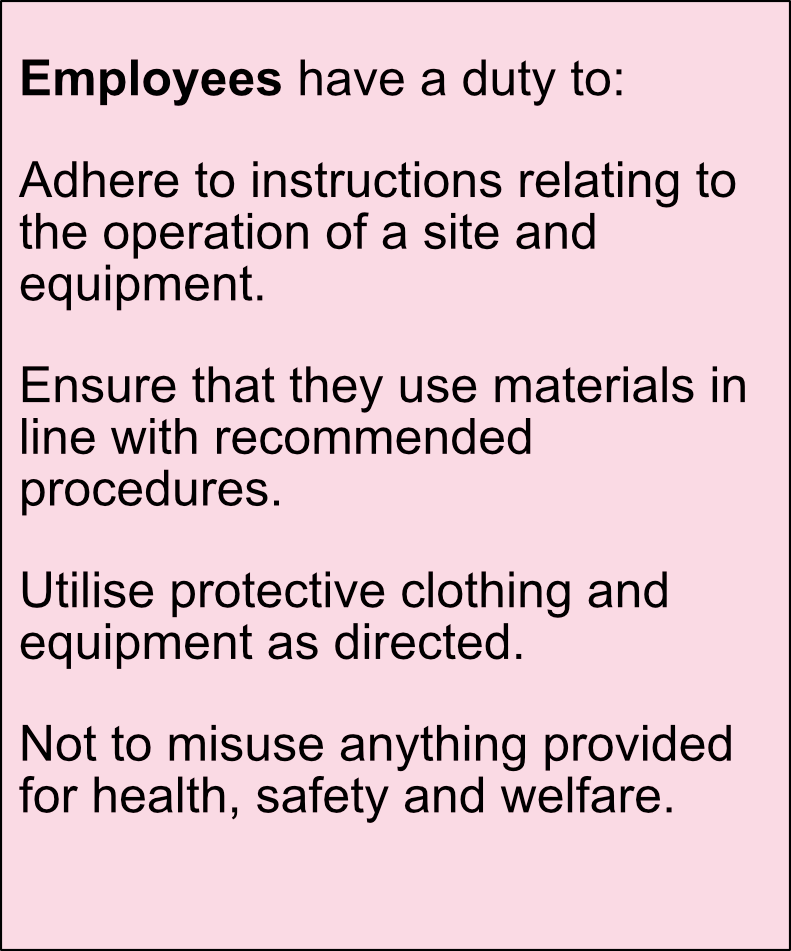
Regardless of their role, every person in an organisation also has the duty to report anything that might affect the health and safety of people in that organisation. For example, if you notice that a power cable is damaged or worn in your work setting, you must report this to an appropriate person, often your line manager. You must never assume that someone else has done this.

Another piece of legislation that governs what you do is the Workplace (Health, Safety and Welfare Regulations 1992. This places a duty on all of us to ensure that the environment we work in, the equipment we use and any systems for working are maintained properly. This means that you should always ensure that your working space is kept sufficiently clean and clear to enable you work without the risk of trips and falls.
If you need to move equipment as part of your role, you must work in line with the Manual Handling Operations Regulations 1992 (amended 2002). This means that you should keep any moving or handling of equipment to a minimum and only do this when necessary. Before you move or carry any pieces of equipment or items like boxes, you must make a suitable assessment of what this will involve and your own capabilities to do it. Your employer has a duty to consider how to minimise risks to the lowest level that is reasonably practical.
The Provision and Use of Work Equipment Regulations (PUWER) 1998 covers any equipment that you use for your role in a work setting. Your employer has a strict liability to ensure that
- equipment is in a good state
- is being used for the purpose it was designed for and is suitable for this
- is properly maintained and inspected
- anyone using it is trained how to do this.
These Regulations have a broad scope that includes fittings in workspaces like cabinets and curtain rails. They also include things like trolleys and tables.
Another important piece of legislation is the Fire (Scotland) Act 2005. A common cause of fires in workplace settings is electrical faults. As most technology equipment is powered, this creates the potential for electrical faults causing fires. Your employer has a duty to carry out risk assessments to minimise any risk of fire occurring. You also have a duty take reasonable care to avoid the risk of fire and follow any fire safety policies and procedures. For example, before using any powered equipment, you must ensure that the power socket is not overloaded and that the cables and plugs are not damaged.
Data Protection and Confidentiality
Data Protection and confidentiality are already core aspects of our roles. Whether it is recording care and support activities, undertaking care planning or communicating with other services, we must all abide by legislation and values to ensure that people’s personal information and privacy are protected. You could argue that this is becoming even more important as we are using more and more digital recording and storing of information about the people we support.
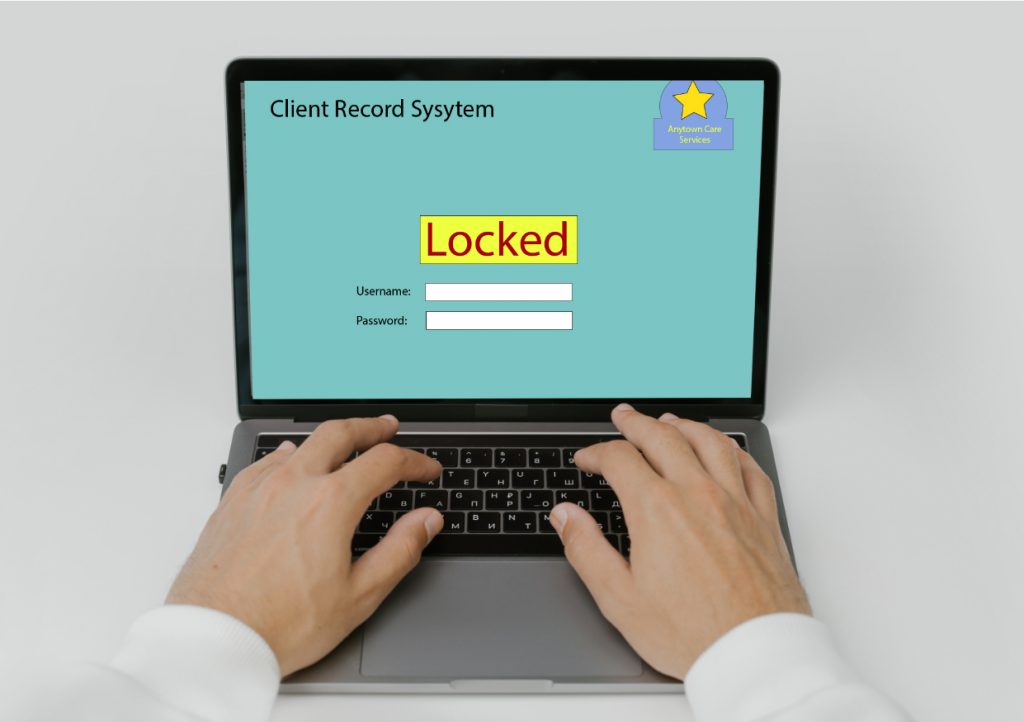
You need to have a good understanding of data protection legislation, not only to ensure that you are working within the law, but also so you can identify where there may be risks for the people you support. For example, if someone using your service is worried about personal information about them being stored by an organisation, you could tell them that they have a right to see anything that it holds about them.
The Data Protection Act 2018 provides the rights for everyone in the United Kingdom, including the following:
- The right to be informed that information is being collected and stored, why this is being done and how long the information will be kept.
- The right of access to any personal data about you that is stored. This is commonly done through a subject access request.
- The right to rectification which means that you have a normally have a right to have any inaccurate information held about you corrected. There are certain circumstances when this can be refused.
- The right to erasure, also known as the ‘right to be forgotten’ means that you can ask for information about you to be erased. This is not an absolute right and only applies in certain circumstances.
- The right to restrict processing is another one that is not absolute and only applies in certain circumstances, however it gives you the right to request that your personal data is not used by an organisation.
- The right to object to processing of your personal data in certain circumstances. You have an absolute right to object to your personal information being used for direct marketing and organisations must remove you from contact lists if you inform them you do not want to receive further marketing communication.
Learning Activity 1
You need to be aware of the legislation that governs your role and the work that you do day to day so that you can work in line with this. Please make a list of the legislation that you need to follow everyday when supporting people using your services and to protect yourself, colleagues and your organisation from harm. Please ensure that you use the full title of the legislation including the year, and include Scotland if appropriate eg. Social Care (Self Directed Support)(Scotland) Act 2013. This is important to show that you know the legislation that applies to your role in Scotland. For each piece of legislation that you identify, please write a couple of sentences to say why and how it applies to your work. Please keep this list and attach it to your application for the MyLearning badge linked to this thing.
Digital Health and Care Strategy: Enabling, Connecting and Empowering – Care in a Digital Age (2021)

Digital Health and Care Strategy: Enabling, Connecting and Empowering – Care in a Digital Age is a refreshed version of The Digital Health and Care Strategy published in 2018 and sets outs the Scottish Government’s aspirations for how its citizens are able to use technology to access and use health and care services.
It contains the three aims below relating to access and greater control over their personal data and access to digital tools and services, a person-centred approach to ensure that this does not get lost through the use of digital technology, and greater use of digital information and data to help improve services and ways of working.
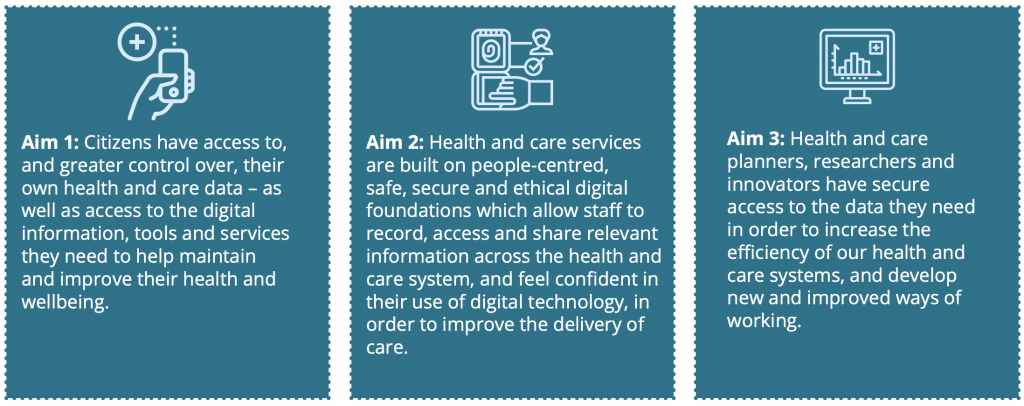
To meet these aims, the Scottish Government and the Convention of Scottish Local Authorities (COSLA) have identified six priorities.
Priority one: People have digital access to information, their own data and services which support their health and wellbeing, wherever they are.
‘Society has seen fundamental changes over the past decade in how technology is used to support access to services, and the ways in which they are offered. People want and expect to have greater choice and control over how – and increasingly when – they access their care, support and services.
This means offering digital and non-digital options.’
Priority two: Digital options are increasingly available as a choice for people accessing services and staff delivering them.
‘The ways care is delivered is changing, with an increasing number of services becoming digital, either fully or in part. These range from basic services, such as ordering repeat prescriptions, booking appointments and accessing trusted online information, to the digital tools and products to help people manage their own health and wellbeing
at home. Over the coming years, digital services will become the first point of contact with health and care services for many people, and will inform how many will choose to engage with health and care services on an ongoing basis. Coupled with the work on digital access, this will result in an overt ‘digital citizen’, who is suitably empowered and enabled to use digital technology to support their individual needs.’
Priority three: The infrastructure, systems, regulation, standards and governance are in place to ensure robust and secure delivery.
‘Alongside our people and our services, digital technology provides the foundation on which our health and care system is built upon. Some of what we have needs modernising or improving. It might still be effective at doing what it was designed for but is not capable of supporting the way we want our modern integrated health and care system to function.’
Priority four: Digital skills are seen as core skills for the workforce across the health and care sector.
‘The success of digital transformation is entirely reliant on people’s ability to know when, why and crucially how to use digital. Workforce development in digital skills, leadership and capabilities across the whole health and care sector underpins the successful uptake and use of digital technologies. The delivery of safe and effective care demands it – from the specialist skills that are essential for the development and running of our digital systems, to the core skills that all frontline health and care professionals need to fully realise the benefits that these systems offer. This is more than developing skills of staff across the sector in relation to technical skills, though this vital, it is also about how staff engage with people who use health and care services.’
Priority five: Our wellbeing and economy benefits as Scotland remains at the heart of digital innovation and development.
‘Advances in technology, and the growth in its use, means we need a constant focus on what is coming next. Scotland is well placed to support the development, design, testing and – ultimately – the adoption of new technology. This ranges from advances in artificial intelligence (AI), 5G, Internet of Things (IoT), through to the apps, tools and products that we increasingly use in our everyday lives, such as smart connected devices in the home and the ever more powerful devices in our pockets.’
Priority six: Data is harnessed to the benefit of citizens, services and innovation.
‘People wonder why their health and care records don’t move with them when they move. They are surprised that hospitals and GPs can’t share medication lists, or that their doctor doesn’t link with their care support worker to coordinate support. They get frustrated that they are asked the same questions at every appointment with different workers in different parts of the health and care system. Data about an individual is often held in multiple different places, making it difficult for people providing support across health and care to access the most relevant, up-to-date information. This makes effective delivery of care, and continuity of care across different service providers and over time as care needs change, more challenging than it needs to be. It also hampers planning and development of services, research, and continuous improvement.’
For more details about each of the six priorities, please read the strategy.
Learning Activity 2
Please choose at least two of the priorities in the Digital Health and Care Strategy and write a note of a minimum of 100 words for each priority you choose that explains what this means for you and the people that you support, or will support, using TEC in your role. Please keep this note as you will need to attach it to your application for the MyLearning badge linked to this Thing.